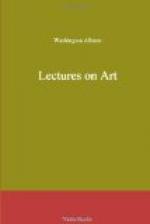For, among the many impossibilities, it is not the least to look upon a living human form as a thing; in its pictured copies, as already shown in a former discourse, it may be a thing, and a beautiful thing; but the moment we conceive of it as living, if it show not a soul, we give it one by a moral necessity; and according to the outward will be the spirit with which we endow it. No poetic being, supposed of our species, ever lived to the imagination without some indication of the moral; it is the breath of its life: and this is also true in the converse; if there be but a hint of it, it will instantly clothe itself in a human shape; for the mind cannot separate them. In the whole range of the poetic creations of the great master of truth,—we need hardly say Shakspeare,—not an instance can be found where this condition of life is ever wanting; his men and women all have souls. So, too, when he peoples the air, though he describe no form, he never leaves these creatures of the brain without a shape, for he will sometimes, by a single touch of the moral, enable us to supply one. Of this we have a striking instance in one of his most unsubstantial creations, the “delicate Ariel.” Not an allusion to its shape or figure is made throughout the play; yet we assign it a form on its very first entrance, as soon as Prospero speaks of its refusing to comply with the” abhorred commands” of the witch, Sycorax. And again, in the fifth act, when Ariel, after recounting the sufferings of the wretched usurper and his followers, gently adds,—
“Your
charm so strongly works them,
That, if you now beheld them, your affections
Would become tender.”
On which Prospero remarks,—
“Hast thou, which art but air, a
touch, a feeling
Of their afflictions?”
Now, whether Shakspeare intended it or not, it is not possible after this for the reader to think of Ariel but in a human form; for slight as these hints are, if they do not indicate the moral affections, they at least imply something akin to them, which in a manner compels us to invest the gentle Spirit with a general likeness to our own physical exterior, though, perhaps, as indistinct as the emotion that called for it.




